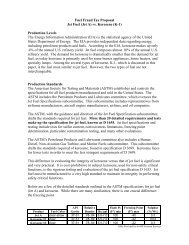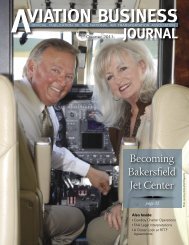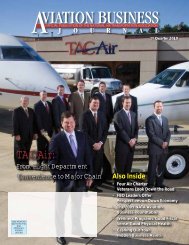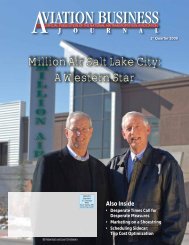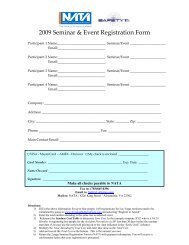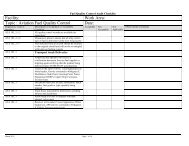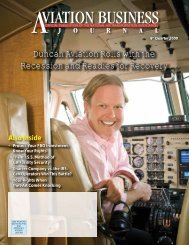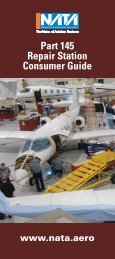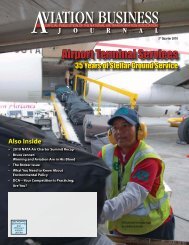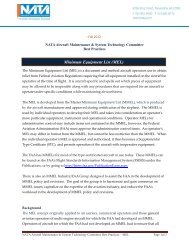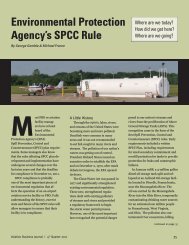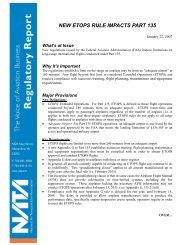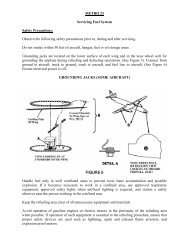Computer-Based Maintenance Tracking Flight Training ... - NATA
Computer-Based Maintenance Tracking Flight Training ... - NATA
Computer-Based Maintenance Tracking Flight Training ... - NATA
- No tags were found...
Create successful ePaper yourself
Turn your PDF publications into a flip-book with our unique Google optimized e-Paper software.
night, seven days a week. I got my private, commercial,and multi-engine rating on that cycle. Ialso got my powerplant mechanic’s license throughthe school, and then I did my airframe licensethrough practical testing because the school didn’toffer it.“So with those ratings, I started looking for a job,and I found one at a small company in Californiaflying an Aztec. I did that for one year,” he said.“It was an import company that was expandinginto the Southwest, and they wanted an airplaneto get around. I flew almost 600 hours as a pilot forthat company. They hired me because I could flyand maintain the airplane, and I was cheap.“From there, I ended up in Dallas, where I feltthere were more flight opportunities than in Phoenix.In Dallas, I went out and beat the bushes for anew flying job. In the late 1960s, the airlines werein a downturn, and I can remember people tellingme ‘Ah, there’s no flying jobs, there’s just no flyingjobs.’ I’d say within ten days I had probably five orsix opportunities. After that experience, I neveragain believed it when somebody said there’s no opportunity.I’d just say, ‘Well they don’t know whatthey’re talking about.’ So I ended up getting hired asa co-pilot/mechanic on a Twin Beech by Frito-Layin January of 1969,” he said.At the time, Frito-Lay’s fleet consisted of theTwin Beech and a Jet Commander. Pepsi Cola andFrito-Lay had merged in 1965 to form Pepsico, andFrito-Lay was growing rapidly. Keith, not entirelyby chance, was in the right place at the right time,career-wise.Houston, We Have a Problem“Six months later I was in the left seat of a TwinBeech, and I’m 21. With 4 passengers aboard, I wasflying from Dallas to Houston, and about 50 milesnorth of Houston the left engine begins to fail. Iknew what was happening, and the only optionwas to shut it down, which I did, before it cameapart. I first noticed that the left engine had an oilleak, I thought ‘Dang, I’m going to have to fix thiswhen we get on the ground. I kept watching it, andit was getting worse. The oil was really starting topour out, and the engine was starting to rock. AndI thought, ‘This is not good,’ and I start pulling thethrottle back and shut it down. We were at 9,000feet at the time, IFR and thunderstorms in thearea. I called Houston, told them we had an enginefailure, and needed a vector to the nearest suitableairport. They said that the then-new HoustonIntercontinental was opening for the first time that“I knew what was happening,and the only option was to shutit down, which I did, before itcame apart.”morning at 8:00 and it was 7:40, so they openedearly for us.“We got a vector for Houston Intercontinental. Wecouldn’t maintain 9,000 feet on one engine so theysaid go down to 6,000 feet, which we couldn’t hold,so they gave us 3,000, all the while with the rightengine at full power.“Finally, they said, ‘Maintain any altitude youcan,’ and I could maintain 2,800, which made methink about all the times I’d taken off out of Lubbockwhere the elevation’s about 3,000 feet,” herecalled.“Take me to the scene of the crash!” he smiled.“Anyway, I guess one of my claims to fame isthat I flew the first landing and the first emergencylanding at Houston Intercontinental Airport, themorning it opened for business. The reporters werewaiting for a Braniff flight. I was able to roll ontoone of the taxiways. I couldn’t taxi the tail wheeleron one engine, so we were stuck there. Of course asit was the first day, everybody was scrambling. Finallya guy comes out with a jeep and a rope, we tiethe rope around both main gears, we loop it aroundthe ball of the tow bar of the jeep, and he startsslowly pulling us. And I am pumping the brakes totry to control it as he pulls us to a ramp.“The passengers weren’t upset at all. They justsaid, ‘Thanks guys. We’ll see you later’ and went totheir meeting.”“So I found a phone, called Dallas, and said,‘We’ve got a problem. We need a new engine on theleft side. This thing isn’t going anywhere.’“Well, the chief pilot said, ‘Get some boxes, takeeverything that’s of any value off the airplane, andleave it.’ We sold it as is, where is,” he said.“The next week, I’m flying the Jet Commander,which I did for about another year, and then wesold it to James Brown. That was interesting. Webought a Falcon 20. At that time, I had just turned23 and got my ATP and type rating on the sameride. I spent most days flying the airplane andabout as many nights maintaining it,” he said.Continued on page 42Aviation Business Journal | 3 rd Quarter 200741


